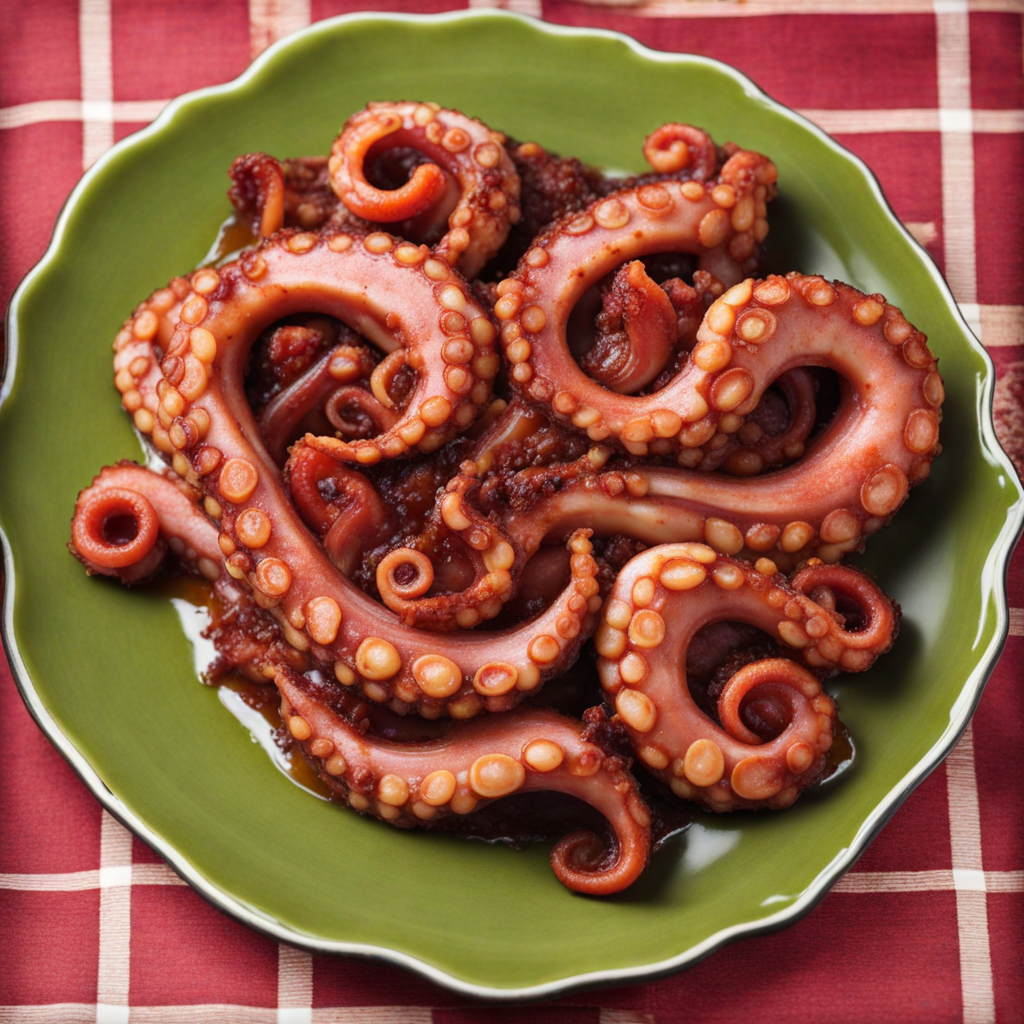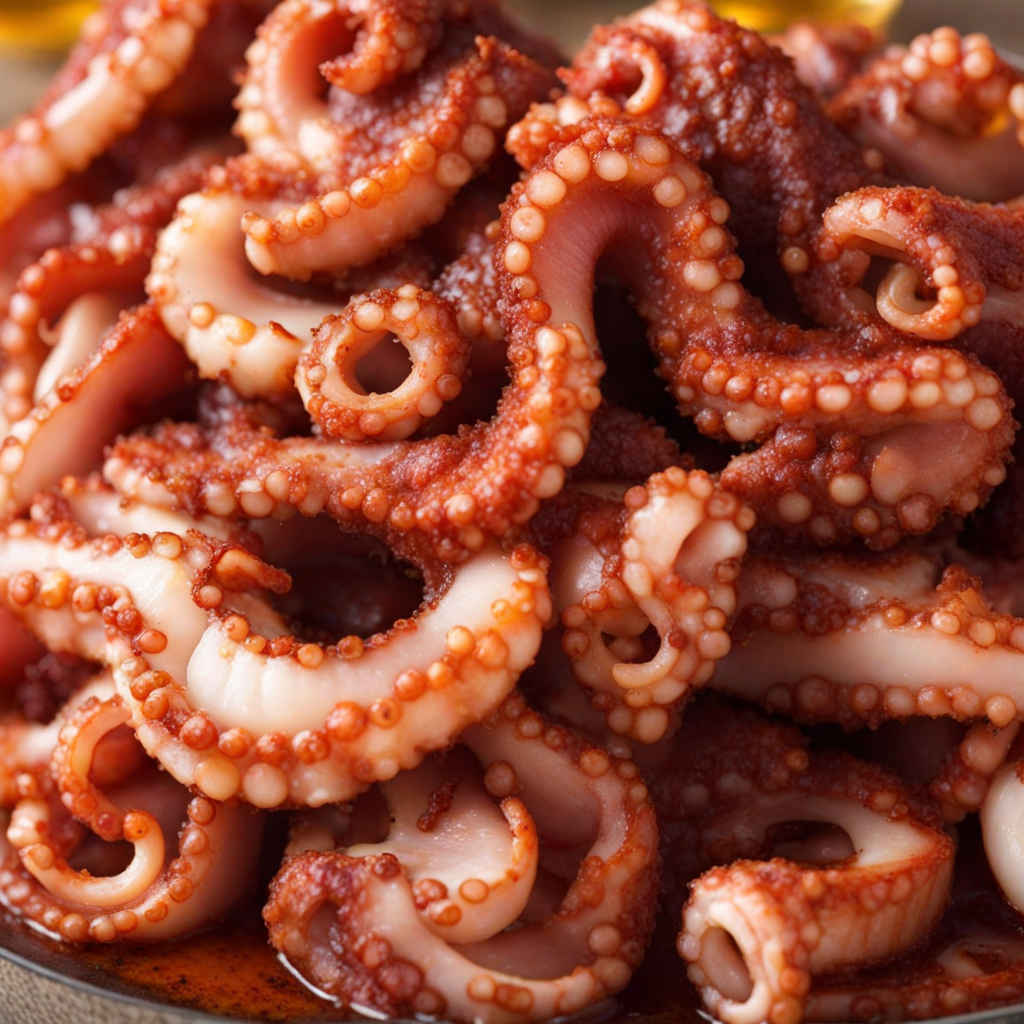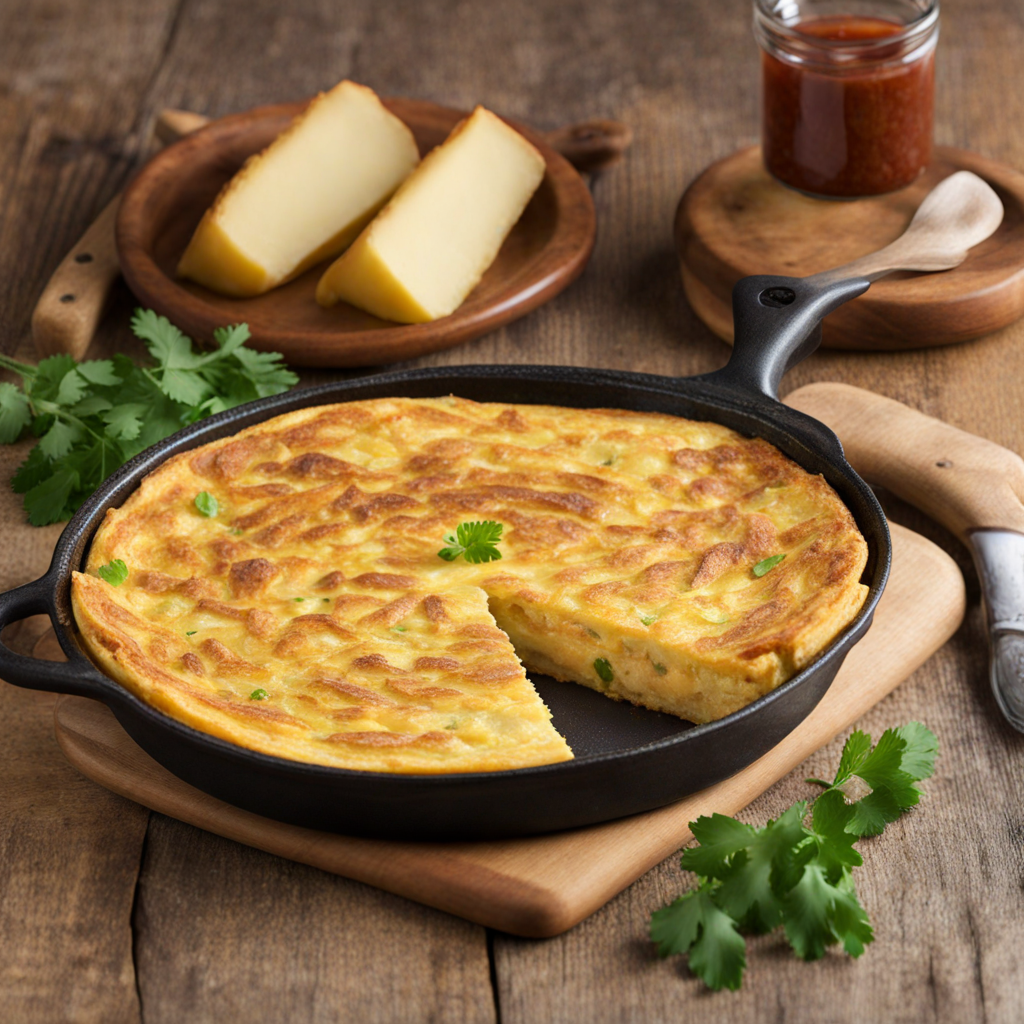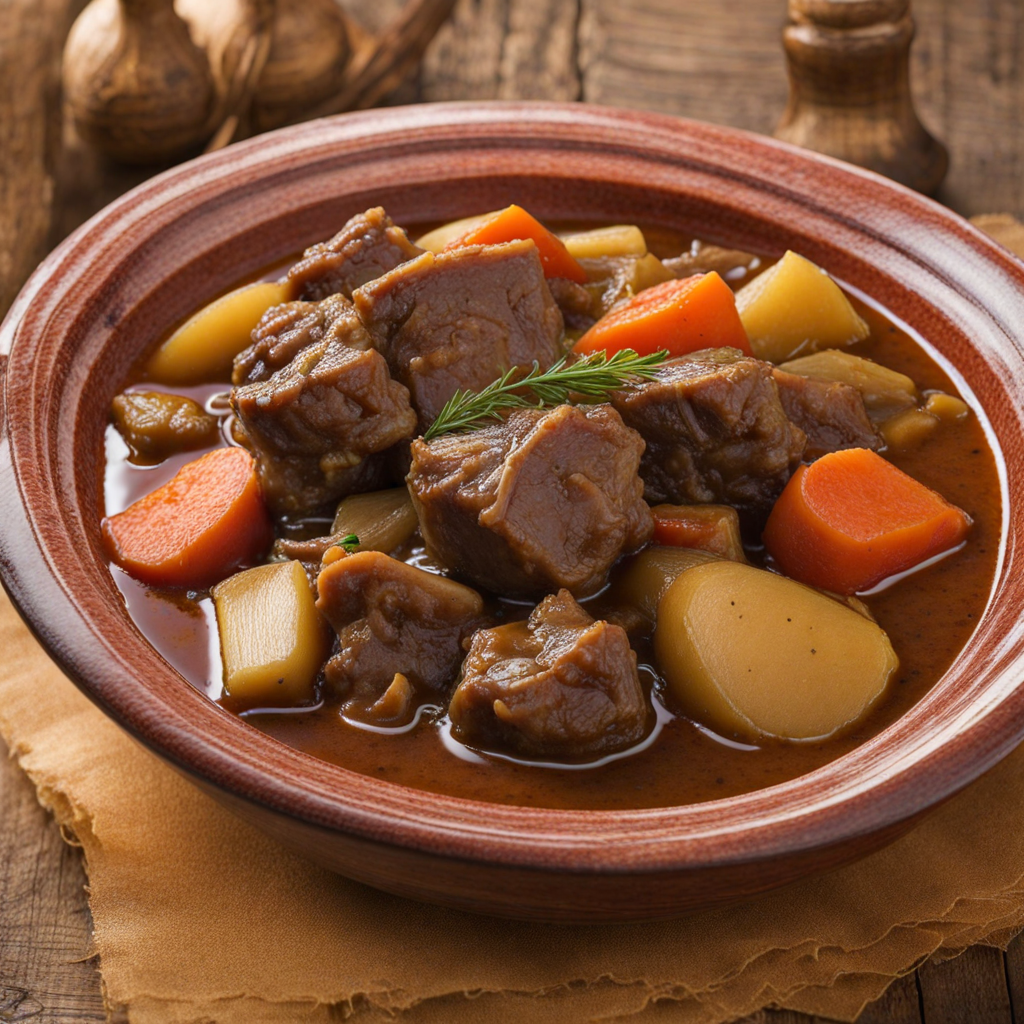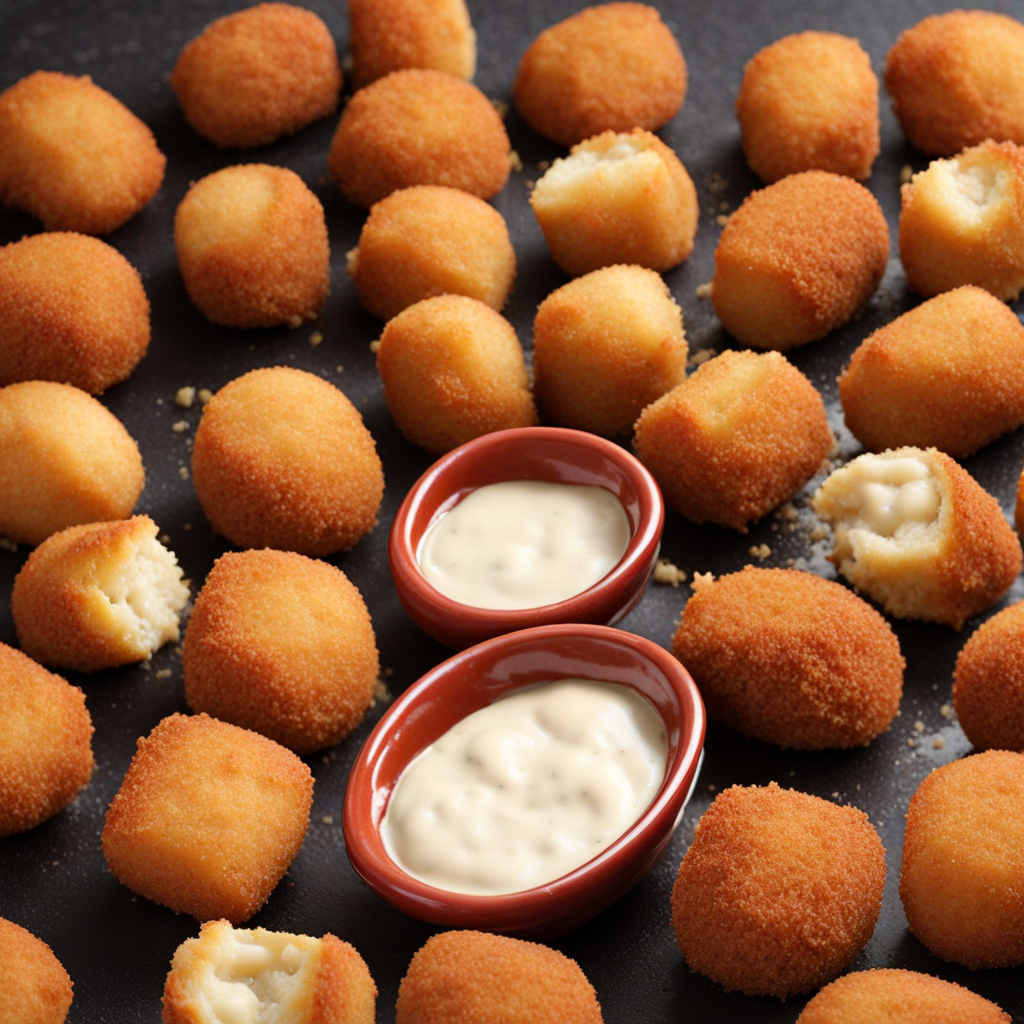Pulpo a la Gallega
Pulpo a la Gallega, also known as Galician-style octopus, is a traditional Spanish dish that originates from the region of Galicia in the northwest of Spain. This dish features tender octopus that is boiled to perfection, resulting in a melt-in-your-mouth texture that highlights the seafood's natural sweetness. The octopus is often cut into thick, circular slices, which showcase its vibrant purple skin and pale, succulent flesh. The preparation is simple yet profound, allowing the quality of the octopus to shine through, making it a beloved dish among seafood enthusiasts. The dish is typically served on a wooden platter and garnished with a drizzle of high-quality extra virgin olive oil, which adds a rich, fruity flavor that complements the octopus beautifully. Additionally, a sprinkle of coarse sea salt enhances the taste, while a dash of smoked paprika introduces a subtle smokiness that elevates the overall flavor profile. The combination of these elements creates a harmonious balance of taste and texture, making each bite a delightful experience. Pulpo a la Gallega is often enjoyed as a tapa, making it a popular choice for sharing among friends and family. It is frequently accompanied by crusty bread, which is perfect for soaking up the delicious olive oil and juices from the octopus. This dish not only captures the essence of Galician cuisine but also reflects Spain's rich culinary heritage, inviting food lovers to explore its unique flavors and embrace the simple yet exquisite pleasure of fresh seafood.
How It Became This Dish
Pulpo a la Gallega: A Culinary Journey Through Time and Space Pulpo a la Gallega, or Galician-style octopus, is a dish that encapsulates the heart and soul of Galicia, a lush region in the northwest of Spain. Renowned for its seafood, rich culinary traditions, and stunning landscapes, Galicia has given us this beloved dish that has transcended borders, becoming a symbol of Spanish cuisine and culture. To understand the significance of Pulpo a la Gallega, we must delve into its origins, cultural importance, and its evolution through the ages. Origins: The Sea and Its Bounty The roots of Pulpo a la Gallega can be traced back to the ancient coastal communities of Galicia, where seafood has been a staple of the diet for centuries. The region's geographical characteristics—its rugged coastline, numerous estuaries, and abundant marine life—have made it a prime location for fishing. The Galicians, who have long relied on the sea for sustenance, naturally gravitated toward octopus, a mollusk that is both plentiful and versatile. Historically, octopus fishing in Galicia dates back to the Celtic tribes that inhabited the region long before the arrival of the Romans. The Celts revered the sea and its creatures, forming a deep connection with marine life. The Romans later introduced more structured fishing practices, but the appreciation for octopus remained strong. The traditional technique of catching octopus involved using handmade traps and nets, passed down through generations. Culinary Significance: A Dish of Simplicity and Tradition Pulpo a la Gallega is characterized by its simplicity, allowing the natural flavors of the octopus to shine. The dish typically features octopus boiled in seawater, then sliced and served over a bed of sliced potatoes. It is traditionally garnished with a drizzle of olive oil, a sprinkle of sea salt, and a dash of pimentón (Spanish paprika). This minimalist approach reflects the Galician philosophy of cooking, which emphasizes high-quality ingredients and straightforward preparation. The dish holds a significant place in Galician culture, often served during festivals, family gatherings, and communal celebrations. One of the most notable celebrations is the Fiesta del Pulpo, held in the town of O Carballiño. This festival is dedicated to the octopus and attracts thousands of visitors who come to savor the dish in its many variations. The festival not only highlights the culinary importance of Pulpo a la Gallega but also serves as a celebration of Galician identity, showcasing the region's agricultural and marine traditions. Evolution Over Time: From Tradition to Global Recognition As the centuries progressed, Pulpo a la Gallega evolved alongside the people of Galicia. The dish remained relatively unchanged in its core preparation, but its presentation and cultural reception began to shift, especially in the latter half of the 20th century. With the advent of modern gastronomy and the rise of Spanish chefs on the international culinary stage, Pulpo a la Gallega began to gain recognition beyond the borders of Galicia. Famed chefs such as Ferran Adrià and José Andrés have played pivotal roles in elevating traditional Spanish dishes, including Pulpo a la Gallega, to new heights. They have introduced innovative techniques and presentations while honoring the essence of the dish. This blending of tradition and modernity has contributed to the global appeal of Pulpo a la Gallega. It is now featured on menus in various countries, often with a unique twist, showcasing the versatility of octopus in contemporary cuisine. Cultural Symbolism: More Than Just a Dish Pulpo a la Gallega is more than just a meal; it is a cultural symbol that embodies the spirit of Galicia. The dish evokes a sense of place and identity, connecting individuals to their heritage and the bountiful sea that sustains them. It represents the Galician people's resilience, their deep-rooted traditions, and their ability to adapt to changing times while remaining true to their culinary heritage. In Galicia, the act of sharing Pulpo a la Gallega is a gesture of hospitality and community. It is often enjoyed in a convivial setting, where friends and family gather around the table to partake in the dish, fostering connections and celebrating togetherness. This communal aspect of dining reflects the Galician ethos, where food serves as a medium for social bonding. Sustainability and Future Directions As with many traditional food practices, Pulpo a la Gallega faces challenges related to sustainability. Overfishing and environmental changes threaten octopus populations, prompting discussions about responsible sourcing and conservation efforts. Galician fishermen and chefs are increasingly aware of these issues, advocating for sustainable practices that ensure the longevity of both the species and the culinary traditions tied to them. In recent years, there has been a growing movement among chefs and home cooks alike to explore the broader context of octopus in the culinary world. This includes experimenting with different cooking techniques, such as grilling or roasting, while still respecting the traditional elements of Pulpo a la Gallega. Additionally, there is a burgeoning interest in foraging and incorporating local ingredients that complement the dish, further enhancing its appeal in the modern culinary landscape. Conclusion: A Culinary Legacy Pulpo a la Gallega is more than just a dish; it is a testament to the rich culinary heritage of Galicia and the enduring connection between people and the sea. From its humble origins among ancient coastal communities to its status as a celebrated dish on international menus, Pulpo a la Gallega tells a story of tradition, resilience, and cultural pride. As we savor this delightful octopus dish, we are reminded of the deep roots it has in Galician culture and the importance of preserving both the dish and the practices that sustain it. In a world that constantly changes, Pulpo a la Gallega stands as a delicious reminder of the beauty of tradition, community, and the simple joy of sharing a meal with loved ones. Whether enjoyed in a bustling Galician town or a trendy restaurant in a faraway city, Pulpo a la Gallega continues to bridge cultures and bring people together, one tender slice at a time.
You may like
Discover local flavors from Spain


